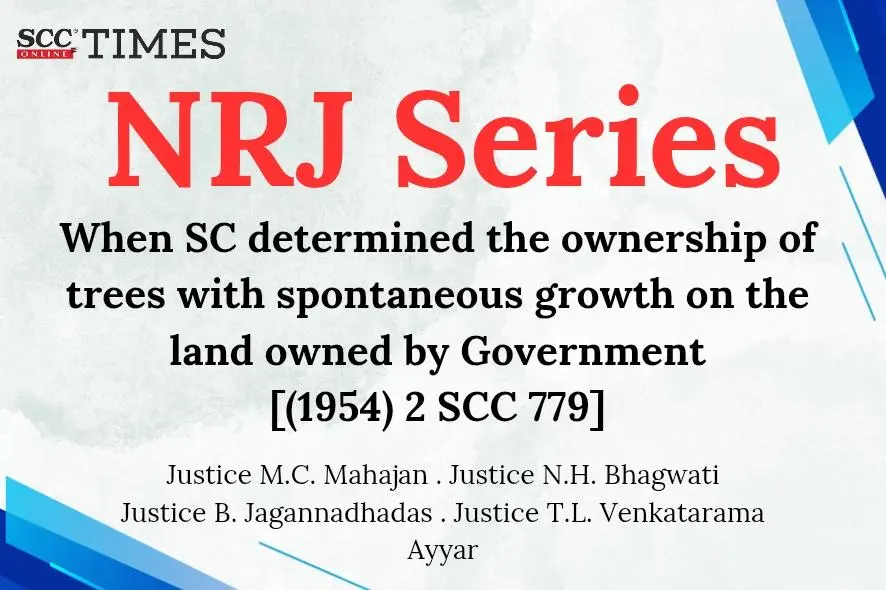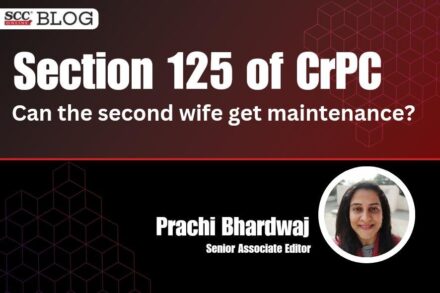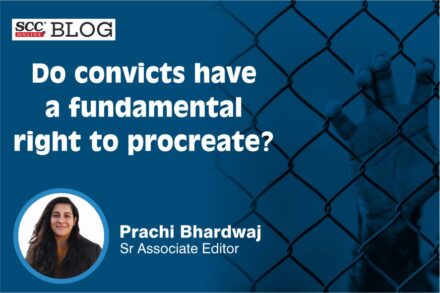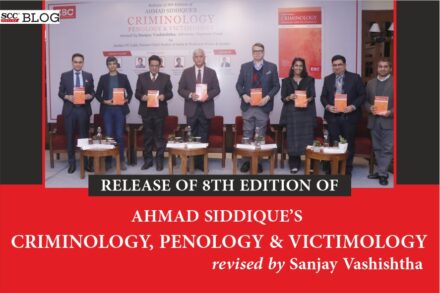Supreme Court: In the present case, an appeal was filed against the judgment and decree dated 11-09-1950 of the Punjab High Court (‘the High Court’), wherein the 4-Judges Bench of M.C. Mahajan*, C.J., and N.H. Bhagwati, B. Jagannadhadas, and T.L. Venkatarama Ayyar, JJ., on determination of the ownership of trees with spontaneous growth on the land owned by the Government (waste land), held that the Government continued to be the owner of such trees as it did not give up its rights over such trees. The Supreme Court held that the ownership of proprietors could be proved by derivative title from the Government, that is, by some act of relinquishment on the Government’s part, which in the present case, was not established. Thus, the Supreme Court held that the Courts below were justified in holding that the Government was the owner of the trees.
Background
A suit was instituted in August 1942 by Nihalu and nine other appellants in the Court of the Senior Sub-Judge, Kangra, Dharamsala, against the State of Punjab for a declaration that the appellants and Defendant 2 held possession as proprietors over land measuring 833 kanals and 2 marlas, situated in Tika Kaseti, Dakhli Ghalaur, Dehra, Kangra. Further, that the entry appearing in the revenue papers that the trees of spontaneous growth were owned by the Government was wrong and should be corrected and that the appellants were entitled to remove the cans and the pattis fixed by the Government to the trees standing on the said land.
Defendant 1 submitted that although the appellants were owners of the said land, the trees of spontaneous growth standing thereon were the property of the Government and the entry in that respect had been correctly in existence since the recent settlement of 1912-1913. The issues for consideration were, (a) have appellants been in possession and enjoying the produce of the trees of spontaneous growth prior to two-and-a-half years before the institution of the suit?, and (b) are the trees of spontaneous growth in the Khasra Nos. in dispute the property of the appellants?.
The Trial Judge decreed the suit in respect of some of Khasra numbers and dismissed the claim regarding the remaining Khasra numbers. This decision was based on the agreed formula that the trees on land brought into the rating in 1868 belonged to the owners, while those on Kharaj-Bachh land were the property of the State. Thus, the appellants were granted a declaration with regard to some of the Khasra numbers.
The appellants and the State appealed to the Court of the District Judge, who by a judgment dated 07-12-1943, dismissed the appeal of the appellants and allowed the appeal of the State. The District Judge concluded by relying on the entries in the Wajib-ul-arz of 1868 and the statements contained therein that all trees of spontaneous growth which were not standing on land in the specific possession of any owner were to be considered the property of the Government. It was further held that to determine in respect of what trees the Government had intended to give up its ownership a special officer was deputed to make an enquiry and prepare a list of such trees. This work was finished in 1917 after which mutations were sanctioned earmarking the trees which belonged to the Government and in the remarks column of the different jamabandies the result of these mutations was incorporated.
The appellants thereafter appealed to the High Court and the Division Bench of that Court opined that to dispose of the points in dispute it was necessary to record additional evidence and thus directed the Financial Commissioner to depute some official to appear in court and produce certain document. The appeal was finally disposed of by the High Court and the decision of the District Judge was affirmed, and it was held that the final decision as to the ownership of trees of spontaneous growth was not reached by Government till 1916. The High Court relied on the Wajib-ul-arz of the settlement of 1912, and on an extract from the record of right, relating to this village in which it was stated “Trees of spontaneous growth in the field Nos. stated in the Jamabandi have been declared to be the property of the Government”, it was held that the trees in the Khasra numbers in dispute were the property of the Government.
Counsel for the appellants submitted that during the settlement of Sir James Lyall in 1868, the Government had in clear terms relinquished its claim to royal trees situated on cultivated lands and on lands entered in the records as private waste and assessed to land revenue and that the land in suit being private waste assessed to land revenue, the entry made in the records of the recent settlement was erroneous. It was further submitted that the ownership of the trees having been already relinquished by the Government in 1868, the onus was on the Government to prove that by some process that ownership was re-acquired in 1917. Further, the ownership in the trees went with the ownership of land and as the appellants were owners of the land on which the trees stood, they must be presumed to be owners of the trees. The Government had no right of passage, even to exercise their alleged right of ownership as it had no right to enter on the land which was the appellants’ private property.
Analysis, Law, and Decision
The Supreme Court opined that none of the appellants’ contentions had any validity as neither the entries in the settlement records of 1868 nor of any later settlement record supported the claim made by them. The Supreme Court stated that what appeared from the statements made in the settlement report of Sir James Lyall was that the State relinquished its claim to royal trees on cultivated land or situated on land entered in the records of that settlement as private waste. The expression “private waste” was defined, and it concerned lands which had been appropriated by a particular owner. The Supreme Court also stated that this matter was elucidated in Anderson’s report on Forest Settlement in the Kangra Valley of the year 1897, wherein it was stated that the waste on which the property in the trees was given to the people was of the nature of “garrhu kharetars” i.e., hay fields lying near the houses or situated among the cultivated fields and which had been assessed nominally at two annas a ghumao. The lands on which the trees in dispute stand did not fall within the definition as these were admittedly not in the possession of any particular proprietor and were described as uncultivated waste.
The Supreme Court noted that in 1916, the matter was again considered by the Government and it was held that all trees on wasteland which were recorded at Lyall’s Settlement as dakhill bachh waste and maqbuza whether owned by more or less than two owners should vest in the owners of the land, except in the case of dakhil bachh areas which were included by Anderson in demarcated protected forests. The trees therefore in respect of which the Government gave up its rights were those situated on cultivated land for which land revenue had been assessed, or those situated on waste lands which had been appropriated by a particular proprietor and were of the description of “garrhu kharetars” and on which land revenue had been assessed, but it never gave up its rights to trees situated on other categories of lands. To specify the lands which fell within the latter description, a detailed enquiry was made during the settlement of 1912-1913 and the result of that enquiry was incorporated by means of mutations in the revenue records. The mutation recorded that “the orders to the effect that the trees of spontaneous growth in khasra numbers…. 38 plots in all, measuring 669 kanals and 18 marlas are the property of the Government”.
The Supreme Court noted that before the mutation was sanctioned, objections were invited by the Settlement Officer himself, but no objection was raised by the appellants themselves or their predecessors-in-interest. The Supreme Court opined that as these entries had by the time of the suit stood in the revenue records for a period of over 25 years and had never been questioned, thus, there was no reason not to accept the evidence furnished by them in favour of the Government and against the appellants. The Supreme Court agreed with the conclusion of the District Judge on the ownership of these trees and stated that the conclusion was final and could not be questioned in a court of second appeal.
The Supreme Court noted that it was admitted that whatever rights the proprietors of the village had in respect to the trees in dispute, were derived by a grant from the Government, and thus it was for the appellants to establish that the Government had at some stage or other transferred its ownership in the trees to them. The Supreme Court opined that there was no satisfactory material on record to establish this. The Supreme Court, after noting that the appellants relied on Letter No. 322-Forest, dated 04-11-1916, opined that the said Letter did not prove any grant of trees to the proprietors. The Supreme Court noted that soon after this letter, the conclusions reached were incorporated in mutations of different villages and the Government expressly declared that the trees in dispute belonged to it.
The Supreme Court rejected the contention that because the ownership in the land was in the appellants they should be presumed to be the owners of the trees and opined that the said contention was not well-founded as it was not unknown that a person might well be the owner of land while another person might be owner of the trees on it. The Supreme Court stated that the said question was one of fact and depended on the circumstances of each case and in the present case, the ownership of the proprietors in the trees could only be proved by a derivative title from Government, that is, by some act of relinquishment on the part of the Government. The Supreme Court, after noting the material placed on the record, opined that it was difficult to hold such relinquishment proved and on the other hand, it appeared that the Government in express terms declined to give up its rights in the trees on the lands in dispute. The Supreme Court noted that after a careful and prolonged enquiry, the matter was settled in 1917 and there was no reason to hold that the result of that enquiry did not indicate the true state of affairs in this matter. Thus, the Supreme Court dismissed the appeal with costs as it was devoid of merit.
[Bakshi Ram v. State of Punjab, (1954) 2 SCC 779, decided on 30-11-1954]
*Judgment authored by: Chief Justice M.C. Mahajan
Advocates who appeared in this case :
For the Appellants: Gurbachan Singh, Senior Advocate (Jindra Lal and Nuanit Lal, Advocates, with him), for the Appellants;
For the Respondents: S.M. Sikri, Advocate general for the State of Punjab (A.N. Grover and P.G. Gokhale, Advocates, with him), for Respondent 1; S.L. Chibber, Advocate, Guardian ad litem, for Respondents 2 and 3.
** Note: Ownership
The term “ownership” means right over a thing to the exclusion of all other persons, implying non-interference by others in the exercise of his rights and the same must be distinguished from a mere holding of a thing in one’s possession. In B. Gangadhar v. B.G. Rajalingam, (1995) 5 SCC 238, the Supreme Court opined that ownership chiefly imports the right of exclusive possession and enjoyment of the thing owned. Ownership implies not so much the physical relation between the person and the thing as the relation between the person owning and the thing owned. Ownership is pre-eminently a right. The right to ownership of a property carries with it the right to its enjoyment, right to its access and of other beneficial enjoyment incidental thereto. If any obstruction or hindrance is caused for its enjoyment or use, the owner, of necessity, has the remedy to have it removed.
In Shrawan Kumar Jaipuriyar v. Krishna Nandan Singh, (2020) 16 SCC 594, the Supreme Court opined that ownership means a bundle of rights which would normally include the right to exclude and transfer the property in a manner one wants, subject to contractual obligations as agreed or statutory restrictions imposed on the owner.






